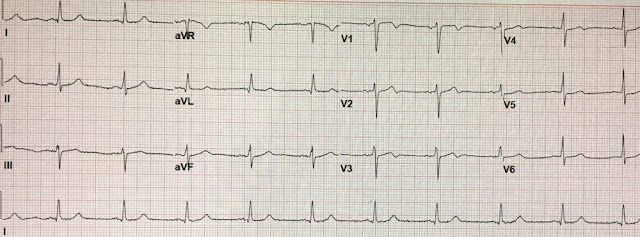This article has been discussed on Twitter today.
It purports to show that you don't need to read the ECG if the computer says "normal". Many on Twitter seem to agree.
The confidence intervals were 97-100%. Would you like to be 97% sure you're not missing an emergency?
So I just looked through a few of my blog cases that were read as "normal" by the computer.
Just as an aside: we are just finishing a manuscript studying a deep neural network EKG algorithm.
We compared the new deep neural network (DNN) from Cardiologs technologies(DNN) to Veritas conventional algorithm: Veritas: 364 "normal"; 5 missed emergencies. DNN: 493 normal; 2 missed.
So things will get better as technology advances.
We are not there yet.
Here are the cases:
It purports to show that you don't need to read the ECG if the computer says "normal". Many on Twitter seem to agree.
Safety of Computer Interpretation of Normal Triage Electrocardiograms
The confidence intervals were 97-100%. Would you like to be 97% sure you're not missing an emergency?
So I just looked through a few of my blog cases that were read as "normal" by the computer.
Just as an aside: we are just finishing a manuscript studying a deep neural network EKG algorithm.
We compared the new deep neural network (DNN) from Cardiologs technologies(DNN) to Veritas conventional algorithm: Veritas: 364 "normal"; 5 missed emergencies. DNN: 493 normal; 2 missed.
So things will get better as technology advances.
We are not there yet.
Here are the cases:
Subtle Dynamic T-waves, Followed by LAD Occlusion and Arrest
This case which I posted on June 12 2017 in response to the article was not my case:






I have to disagree with you here. The constant interruptions come at a huge cost in terms of attention. I am unlikely to pick up subtle findings during a shift. The question is not whether the computer misses things, but how many of those missed findings occur in patients who look clinically well? Ill appearing patients should be selected for scrutiny by the nursing staff anyway.
ReplyDeleteAll of these patients looked clinically well. Most STEMI and ACS patients look clinically well, only complain of chest pain or SOB, like so many other patients. Furthermore, only 20% of ECGs are labelled normal by the computer. It will decrease the number of ECGs by 20%.
DeleteAlthough this discussion does not really pertain to paramedics as myself, since we usually only have one patient at a time so reviewing each ECG is not a big deal, but I have activated cath lab a few times from the field with ECGs that the monitor read as normal.
ReplyDeleteAmen!
DeleteWe should always be looking for subtle findings. It’s what distinguishes you from just a regular doctor.
ReplyDeleteExactly!
DeleteSteve,
ReplyDeleteThis is a great discussion topic for my medics and group. Ty!
Yes!
DeleteIm absolutely delighted that you are developing a DNN for ECG computer interpretation, maybe then when we hightlight these significant but subtle ECG abnormalities we will be taken more seriously by the medical staff. Please keep us posted on the developments of this tool
ReplyDeleteThis is an example from my practice of LAD occlusion where the ECG interpreted as normal
ReplyDeletehttps://imgur.com/a/FvgIE
Good case! Clearly acute LAD occlusion.
DeleteThis supports the value of repeat ECG in the chest pain patient with some clinical suspicion.
ReplyDeleteGet serial ECG if any doubt.
ReplyDeleteInteresting blog, your opinion is great, I hope you introduce more computer and ECG related knowledge.
ReplyDelete